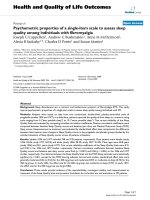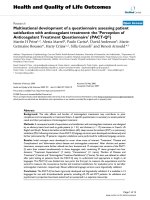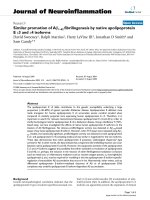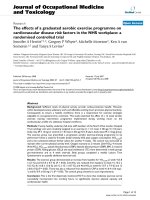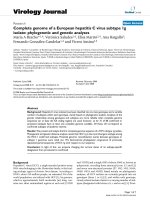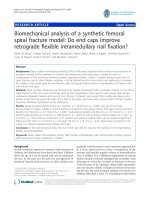Báo cáo hóa học: " NIELSEN NUMBER OF A COVERING MAP" pptx
Bạn đang xem bản rút gọn của tài liệu. Xem và tải ngay bản đầy đủ của tài liệu tại đây (526.1 KB, 11 trang )
NIELSEN NUMBER OF A COVERING MAP
JERZY JEZIERSKI
Received 23 November 2004; Revised 13 May 2005; Accepted 24 July 2005
We consider a finite regular covering p
H
:
X
H
→ X over a compact polyhedron and a map
f : X
→ X admitting a lift
f :
X
H
→
X
H
. We show some formulae expressing the Nielsen
number N( f ) as a linear combination of the Nielsen numbers of its lifts.
Copyright © 2006 Jerzy Jezierski. This is an open access article distributed under the Cre-
ative Commons Attribution License, which permits unrestricted use, distribution, and
reproduction in any medium, provided the original work is properly cited.
1. Introduction
Let X be a finite polyhedron and let H be a normal subgroup of π
1
(X). We fix a covering
p
H
:
X
H
→ X corresponding to the subgroup H, that is, p
#
(π
1
(
X
H
)) = H.
We assume moreover that the subgroup H has finite rank, that is, the covering p
H
is
finite. Let f : X
→ X be a map satisfying f (H) ⊂ H.Then f admits a lift
X
H
f
p
H
X
H
p
H
X
f
X
(1.1)
Is it possible to find a formula expressing the Nielsen number N( f )bythenumbers
N(
f )where
f runs the set of all lifts? Such a for mula seems very desirable since the
difficulty of computing the Nielsen number often depends on the size of the fundamental
group. Since π
1
X ⊂ π
1
X, the computation of N(
f ) may be simpler. We will translate this
problem to algebra. The main result of the paper is Theorem 4.2 expressing N( f )asa
linear combination of
{N(
f
i
)}, where the lifts are representing all the H-Reidemeister
classes of f .
The discussed problem is analogous to the question about “the Nielsen number prod-
uct formula” raised by Brown in 1967 [1]. A locally triv ial fibre bundle p : E
→ B and a
Hindawi Publishing Corporation
Fixed Point Theory and Applications
Volume 2006, Article ID 37807, Pages 1–11
DOI 10.1155/FPTA/2006/37807
2 Nielsen number of a covering map
fibre map f : E
→ E were given and the question was how to express N( f )byN( f )and
N( f
b
), where f : B → B denoted the induced map of the base space and f
b
was the restric-
tion to the fibre over a fixed point b
∈ Fix( f ). This problem was intensively investigated
in 70ties and finally solved in 1980 by You [4]. At first sufficient conditions for the “prod-
uct formula” were formulated: N( f )
= N( f )N( f
b
) assuming that N( f
b
)isthesamefor
all fixed points b
∈ Fix( f ). Later it turned out that in general it is better to expect the
formula
N( f )
= N
f
b
1
+ ···+ N
f
b
s
, (1.2)
where b
1
, ,b
s
represent all the Nielsen classes of f . One may find an analogy between
the last formula and the formulae of the present paper. There are also other analogies: in
both cases the obstr uctions to the above equalities lie in the subgroups
{α ∈ π
1
X; f
#
α =
α}⊂π
1
X.
2. Preliminaries
We recall the basic definitions [2, 3]. Let f : X
→ X be a self-map of a compact polyhe-
dron. Let Fix( f )
={x ∈ X; f (x) = x} denote the fixed point set of f . We define the Nielsen
relation on Fix( f )puttingx
∼ y if there is a path ω : [0,1] → X such that ω(0) = x,
ω(1)
= y and the paths ω, fω are fixed end point homotopic. This relation splits the
set Fix( f ) into the finite number of classes Fix( f )
= A
1
∪···∪A
s
.AclassA ⊂ Fix( f )
is called essential if its fixed point index ind( f ;A)
= 0. The number of essential classes is
called the Nielsen number and is denoted by N( f ). This number has two important prop-
erties. It is a homotopy invariant and is the lower bound of the number of fixed points:
N( f )
≤ #Fix(g)foreverymapg homotopic to f .
Similarly we define the Nielsen relation modulo a nor mal subgroup H
⊂ π
1
X.Weas-
sume that the map f preserves the subgroup H, that is, f
#
H ⊂ H. We say that then x ∼
H
y
if ω
= fωmodH for a path ω joining the fixed points x and y. This yields H-Nielsen classes
and H-Nielsen number N
H
( f ). For the details see [4].
Let us notice that each Nielsen class modH splits into the finite sum of ordinary
Nielsen classes (i.e., classes modulo the trivial subg roup): A
= A
1
∪···∪A
s
. On the other
hand N
H
( f ) ≤ N( f ).
We consider a regular finite covering p :
X
H
→ X as described above.
Let
ᏻ
XH
=
γ :
X
H
−→
X
H
; p
H
γ = p
H
(2.1)
denote the group of natural transformations of this covering and let
lift
H
( f ) =
f :
X
H
−→
X
H
; p
H
f = fp
H
(2.2)
denote the set of all lifts.
Jerzy Jezierski 3
We start by recalling classical results giving the correspondence between the coverings
and the fundamental groups of a space.
Lemma 2.1. There is a bijection ᏻ
XH
= p
−1
H
(x
0
) = π
1
(X)/H which can be described as fol-
lows:
γ
∼ γ
x
0
∼
p
H
(γ). (2.3)
We fix a point
x
0
∈ p
−1
H
(x
0
). For a natural transformation γ ∈ ᏻ
XH
, γ(x
0
) ∈ p
−1
H
(x
0
) is a
point and
γ is a path in
X
H
joining the points x
0
and γ(x
0
). The bijection is not canonical. It
depends on the choice of x
0
and x
0
.
Let us notice that for any two lifts
f ,
f
∈ lift
H
( f ) there exists a unique γ ∈ ᏻ
XH
satis-
fying
f
= γ
f . More precisely, for a fixed lift
f , t he correspondence
ᏻ
XH
α −→ α
f ∈ lift
H
( f ) (2.4)
is a bijection. This correspondence is not canonical. It depends on the choice of
f .
The group ᏻ
XH
is acting on lift
H
( f )bytheformula
α
◦
f = α ·
f · α
−1
(2.5)
and the orbits of this action are called Reidemeister classes modH and their set is denoted
H
( f ). Then one can easily check [3]
(1) p
H
(Fix(
f )) ⊂ Fix( f )iseitherexactlyoneH-Nielsen class of the map f or is
empty (for any
f ∈ lift
H
( f ))
(2) Fix( f )
=
f
p
H
(Fix(
f )) where the summation runs the set lift
H
( f )
(3) if p
H
(Fix(
f )) ∩ p
H
(Fix(
f
)) =∅ then
f ,
f
represent the same Reidemeister
class in
H
( f )
(4) if
f ,
f
represent the same Reidemeister class then p
H
(Fix(
f )) = p
H
(Fix(
f
)).
Thus Fix( f )
=
f
p
H
(Fix(
f )) is the disjoint sum where the summation is over a sub-
set containing exactly one lift
f from each H-Reidemeister class. This gives the natu-
ral inclusion from the set of Nielsen classes modulo H into the set of H-Reidemeister
classes
ᏺ
H
( f ) −→
H
( f ). (2.6)
The H-Nielsen class A is sent into the H-Reidemeister class represented by a lift
f satis-
fying p
H
(Fix(
f )) = A. By (1) and (2) such lift exists, by (3) the definition is correct and
(4) implies that this map is injective.
4 Nielsen number of a covering map
3. Lemmas
For a lift
f ∈ lift
H
( f ), a fixed point x
0
∈ Fix( f ) and an element β ∈ π
1
(X;x
0
)wedefine
the subgroups
ᐆ(
f ) =
γ ∈ ᏻ
XH
;
fγ= γ
f
C
f
#
,x
0
;β
=
α ∈ π
1
X;x
0
; αβ = βf
#
(α)
C
H
f
#
,x
0
;β
=
[α]
H
∈ π
1
X;x
0
/H
x
0
; αβ = βf
#
(α)moduloH
.
(3.1)
If β
= 1 we will wr i te simply C( f
#
,x
0
)orC
H
( f
#
,x
0
).
We notice that the canonical projection j : π
1
(X;x
0
) → π
1
(X;x
0
)/H(x
0
) induces the
homomorphism j : C( f
#
,x
0
;β) → C
H
( f
#
,x
0
;β).
Lemma 3.1. Let
f be a lift of f and let
A be a Nielsen class of
f . Then p
H
(
A) ⊂ Fix( f ) is
aNielsenclassof f . On the other hand if A
⊂ Fix( f ) is a Nielsen class of f then p
−1
H
(A) ∩
Fix(
f ) splits into the finite sum of Nielsen classes of
f .
Proof. It is evident that p
H
(
A) is contained in a Nielsen class A ⊂ Fix( f ). Now we show
that A
⊂ p
H
(
A). Let us fix a point x
0
∈
A and let x
0
= p
H
(x
0
). Let x
1
∈ A.Wehaveto
show that x
1
∈ p
H
(
A). Let ω : I → X establish the Nielsen relation between the points
ω(0)
= x
0
and ω(1) = x
1
and let h(t, s) denote the homotopy between ω = h(·,0) and
fω
= h(·,1). Then the path ω lifts to a path ω : I →
X
H
, ω(0) =
x
0
. Let us denote ω(1) =
x
1
. It remains to show that x
1
∈
A. The homotopy h lifts to
h : I × I →
X
H
,
h(0,s) =
x
0
.
Then the paths
h(·,1) and
f ω as the lifts of fωstarting from x
0
are equal. Now
f (x
1
) =
f ( ω(1)) =
h(1,1) =
h(1,0) =
ω(1) =
x
1
.Thusx
1
∈ Fix(
f ) and the homotopy
h gives the
Nielsen relation between
x
0
and x
1
hence x
1
∈
A.
Now the second part of the lemma is obvious.
Lemma 3.2. Let
A ⊂ Fix(
f ) beaNielsenclassof
f .LetusdenoteA = p
H
(
A). Then
(1) p
H
:
A → A isacoveringwherethefibreisinbijectionwiththeimagej
#
(C( f
#
,x)) ⊂
π
1
(X;x)/H(x) for x ∈ A,
(2) the cardinality of the fibre (i.e., #(p
−1
H
(x) ∩
A)) does not depend on x ∈ A and we will
denote it by J
A
,
(3) if
A
is another Nielsen class of
f satisfying p
H
(
A
) = p
H
(
A) then the cardinalities of
p
−1
H
(x) ∩
A and p
−1
H
(x) ∩
A
are the same for each point x ∈ A.
Proof. (1) Since p
H
is a local homeomorphism, the projection p
H
:
A → A is the covering.
(2) We will show a bijection φ : j(C( f
#
;x
0
)) → p
−1
H
(x
0
) ∩
A (for a fixed point x
0
∈ A).
Let α
∈ C( f
#
). Let us fix a point x
0
∈ p
−1
H
(x
0
). Let α : I →
X denote the lift of α starting
from
α(0) =
x
0
.Wedefineφ([α]
H
) =
α(1). We show that
(2a) The definition is correct. Let [α]
H
= [α
]
H
.Thenα ≡ α
modH hence α(1) =
α
(1). Now we show that α(1) ∈
A.Sinceα ∈ C( f
#
), there exists a homotopy h between
the loops h(
·,0) = α and h(·,1) = fα. The homotopy lifts to
h : I × I →
X
H
,
h(0,s) = x
0
.
Then
x
1
=
h(1,s)isalsoafixedpointof
f and moreover
h is the homotopy between the
paths
ω and
f ω.Thusx
0
, x
1
∈ Fix(
f ) are Nielsen related hence x
1
∈
A.
Jerzy Jezierski 5
(2b) φ is onto. Let
x
1
∈ p
−1
H
(x
0
) ∩
A.Nowx
0
, x
1
∈ Fix(
f ) are Nielsen related. Let ω :
I
→
X
H
establish this relation (
f ω ∼ ω). Now
f
p
H
ω
=
p
H
f ω ∼ p
H
ω (3.2)
hence p
H
ω ∈ C( f
#
;x
0
). Moreover φ[p
H
ω]
H
=
ω(1) =
x
1
.
(2c) φ is injective. Let [α]
H
,[α
]
H
∈ j(C( f
#
)) and let α, α
: I →
X
H
be their lifts starting
from
α(0) =
α
(0) =
x
0
. Suppose that φ[α]
H
= φ[α
]
H
. This means α(1) =
α
(1) ∈
X
H
.
Thus p
H
(α∗α
−1
) = α∗α
−1
∈ H which implies [α]
H
= [α
]
H
.
(3) Let x
0
∈ p
H
(
A) = p
H
(
A
). Then by the above #(p
−1
(x
0
) ∩
A) = j
#
(C( f
#
)) =
#(p
−1
(x
0
) ∩
A
).
Lemma 3.3. The restriction of the covering map p
H
:Fix(
f ) → p
H
(Fix(
f )) is a covering.
The fibre over each point is in a biject ion with the set
ᐆ(
f ) =
γ ∈ ᏻ
XH
;
fγ= γ
f
. (3.3)
Proof. Since the fibre of the covering p
H
is discrete, the restriction p
H
:Fix(
f ) →
p
H
(Fix(
f )) is a locally trivial bundle. Let us fix points x
0
∈ p
H
(Fix(
f )), x
0
∈ p
−1
H
(x
0
) ∩
Fix(
f ). We recall that
α : p
−1
H
x
0
−→
ᏻ
XH
, (3.4)
where α
x
∈ ᏻ
XH
is characterized by α
x
(x
0
) =
x, is a bijection. We will show that
α(p
−1
H
(x
0
) ∩ Fix(
f )) = ᐆ(
f ).
Let
f (x) =
x for an x ∈ p
−1
H
(x
0
). Then
fα
x
x
0
=
f (x) =
x = α
x
x
0
=
α
x
f
x
0
(3.5)
which implies
fα
x
= α
x
f hence α
x
∈ ᐆ(
f ).
Now we assume t hat
fα
x
= α
x
f .Theninparticular
fα
x
(x
0
) = α
x
f (x
0
) which gives
f (x) = α
x
(x
0
),
f (x) =
x hence x ∈ Fix(
f ).
We will denote by I
A
H
the cardinality of the subgroup #ᐆ(
f )fortheH-Nielsen class
A
H
= p
H
(Fix(
f )). We will also write I
A
i
= I
A
H
for any Nielsen class A
i
of f contained in
A.
Lemma 3.4. Let A
0
⊂ Fix( f ) be a Nielsen class and let
A
0
⊂ Fix(
f ) be a Nielsen class con-
tained in p
−1
H
(A
0
).Then,byLemma 3.1 A
0
= p
H
(
A
0
) and moreover
ind
f ; p
−1
H
A
0
=
I
A
0
· ind
f ; A
0
ind
f ;
A
0
=
J
A
0
· ind
f ; A
0
.
(3.6)
6 Nielsen number of a covering map
Proof. Since the index is the homotopy invariant we may assume that Fix( f )isfinite.Now
for any fixed points x
0
∈ Fix( f ), x
0
∈ Fix(
f ) satisfying p
H
(x
0
) = x
0
we have ind(
f
0
; x
0
) =
ind( f
0
;x
0
) since the projection p
H
is a local homeomorphism. Thus
ind
f ; p
−1
H
A
0
=
x∈A
0
ind
f ; p
−1
H
(x)
=
x∈A
0
I
A
0
· ind( f ;x)
= I
A
0
x∈A
0
ind( f ;x) = I
A
0
· ind
f ; A
0
.
(3.7)
Similarly we prove the second equality:
ind
f ;
A
0
=
x∈A
0
ind
f ; p
−1
H
(x) ∩
A
0
=
x∈A
0
x∈ p
−1
H
(x)∩
A
0
ind
f ; x
=
x∈A
0
J
A
0
· ind( f ;x) = J
A
0
·
x∈A
0
ind( f ;x)
=
J
A
0
· ind
f ; A
0
.
(3.8)
To get a formula expressing N( f )bythenumbersN(
f ) we will need the assumption
that the numbers J
A
= J
A
for any two H-Nielsen related classes A, A
⊂ Fix( f ). The next
lemma gives a sufficient condition for such equality.
Lemma 3.5. Let x
0
∈ p(Fix(
f )). If the subgroups H(x
0
),C( f ,x
0
) ⊂ π
1
(X,x
0
) commute,
that is, h
· α = α · h,foranyh ∈ H(x
0
), α ∈ C( f ,x
0
), then J
A
= J
A
for al l Nielsen classes
A,A
⊂ p(Fix(
f )).
Proof. Let x
1
∈ p(Fix(
f )) be another point. The points x
0
,x
1
∈ p(Fix(
f )) are H-Nielsen
related, that is, there is a path ω : [0,1]
→ X satisfying ω(0) = x
0
, ω(1) = x
1
such that
ω
∗ f (ω
−1
) ∈ H(x
0
). We will show that the conjugation
π
1
X,x
0
α −→ ω
−1
∗ α ∗ ω ∈ π
1
X,x
1
(3.9)
sends C( f ,x
0
)ontoC( f ,x
1
). Let α ∈ C( f ,x
0
). We w ill show that ω
−1
∗ α ∗ ω ∈ C( f ,x
1
).
In fact f (ω
−1
∗ α ∗ ω) = ω
−1
∗ α ∗ ω ⇔ (ω∗ fω
−1
) ∗ α = α ∗ (ω∗ fω
−1
)butthelast
equality holds since ω
∗ fω
−1
∈ H(x
0
)andα ∈ C( f ,x
0
).
Remark 3.6. The assumption of the above lemma is satisfied if at least one of the groups
H(x
0
), C( f ,x
0
)belongstothecenterofπ
1
(X;x
0
).
Remark 3.7. Let us notice that if the subgroups H(x
0
),C( f ,x
0
) ⊂ π
1
(X,x
0
)commutethen
so do the corresponding subgroups at any other point x
1
∈ p
H
(Fix(
f )).
Proof. Let us fix a path ω : [0,1]
→ X. We will show that the conjugation
π
1
X,x
0
α −→ ω
−1
∗ α ∗ ω ∈ π
1
X,x
1
(3.10)
sends C( f ,x
0
)ontoC( f ,x
1
). Let α ∈ C( f ,x
0
). We w ill show that ω
−1
∗ α ∗ ω ∈ C( f ,x
1
).
But the last means f (ω
−1
∗ α ∗ ω) = ω
−1
∗ α ∗ ω hence f (ω
−1
) ∗ fα∗ fω= ω
−1
∗ α ∗
ω ⇔ f (ω
−1
) ∗ α ∗ fω= ω
−1
∗ α ∗ ω ⇔ (ω ∗ fω
−1
) ∗ α = α ∗ (ω ∗ fω
−1
) and the last
Jerzy Jezierski 7
holds since (ω
∗ fω
−1
) ∈ H(x
0
)andα ∈ C( f ,x
0
). Now it remains to notice that the el-
ements of H(x
1
), C( f ;x
1
) are of the form ω
−1
∗ γ ∗ ω and ω
−1
∗ α ∗ ω respectively for
some γ
∈ H(x
0
)andα ∈ C( f ,x
0
).
Now we will express the numbers I
A
, J
A
in terms of the homotopy group homomor-
phism f
#
: π
1
(X,x
0
) → π
1
(X,x
0
) for a fixed point x
0
∈ Fix( f ). Let
f :
X
H
→
X
H
be a lift
satisfying
x
0
∈ p
−1
H
(x
0
) ∩ Fix(
f ). We also fix the isomorphism
π
1
X;x
0
/H
x
0
α −→ γ
α
∈ ᏻ
XH
, (3.11)
where γ
α
(x
0
) =
α(1) and α denotes the lift of α starting from α(0) =
x
0
.
We will describe the subgroup corresponding to C(
f ) by this isomorphism and then
we will do the same for the other lifts
f
∈ lift
H
( f ).
Lemma 3.8.
fγ
α
= γ
fα
f. (3.12)
Proof.
fγ
α
x
0
=
f α(1) = γ
fα
x
0
=
γ
fα
f
x
0
, (3.13)
where the middle equality holds since
f α is a lift of the path fαfrom the point x
0
.
Corollary 3.9. There is a bijection between
ᐆ(
f ) =
γ ∈ ᏻ
XH
;
fγ= γ
f
,
C
H
( f ) =
α ∈ π
1
X;x
0
/H
x
0
; f
H#
(α) = α
.
(3.14)
Thus
I
A
/J
A
= #ᐆ(
f )/# j
C( f )
=
#
C
H
( f )/j
C( f )
. (3.15)
Let us emphasize that C( f ), C
H
( f ) are the subgroups of π
1
(X;x
0
)orπ
1
(X;x
0
)/H(x
0
)
respectively where the base point is the chosen fixed point. Now will take another fixed
point x
1
∈ Fix( f ) and we will denote C
( f ) ={α
∈ π
1
(X;x
1
); f
#
α = α} and similarly we
define C
H
( f ). We will express the cardinality of t hese subgroups in terms of the group
π
1
(X;x
0
).
Lemma 3.10. Let η : [0,1]
→ X be a path from x
0
to x
1
. This path gives rise to the isomor-
phism P
η
: π
1
(X;x
1
) → π
1
(X;x
0
) by the formula P
η
(α) = ηαη
−1
.Letδ = η · ( fη)
−1
. Then
P
η
C
( f )
=
α ∈ π
1
X;x
0
; αδ = δf
#
(α)
P
η
C
H
( f )
=
[α] ∈ π
1
X;x
0
/H
x
0
; αδ = δf
#
(α) modulo H
.
(3.16)
8 Nielsen number of a covering map
Proof. We notice that δ is a loop based at x
0
representing the Reidemeister class of the
point x
1
in ( f ) = π
1
(X;x
0
)/.
We will denote the right-hand side of the above equalities by C( f ;δ)andC
H
( f ;δ)
respectively. Let α
∈ π
1
(X;x
1
). We denote α = P
η
(α
) = ηα
η
−1
. We will show that α ∈
C( f ;δ) ⇔ α
∈ C
( f ).
In fact α
∈ C( f ;δ) ⇔ αδ = δ · fα⇔ (ηα
η
−1
)(η · fη
−1
) = (η · fη
−1
)( fη· fα
·
( fη)
−1
) ⇔ ηα
· ( fη)
−1
= η · fα
· ( fη)
−1
⇔ α
= fα
.
Similarly we prove the second equality.
Thus we get the following formulae for the numbers I
A
, J
A
.
Corollary 3.11. Let δ
∈ π
1
(X;x
0
) represent the Reidemeister class A ∈ ( f ). Then I
A
=
#C
H
( f ; j(δ)), J
A
= # j(C( f ;δ)).
4. Main theorem
Lemma 4.1. Let A
⊂ p
H
(Fix(
f )) beaNielsenclassof f . Then p
−1
H
A contains exactly I
A
/J
A
fixed point classes of
f .
Proof. Since the projection of each Nielsen class
A ⊂ p
−1
H
(A) ∩ Fix(
f )isontoA (Lemma
3.1), it is enough to check how many Nielsen classes of
f cut p
−1
H
(a) for a fixed point
a
∈ A.ButbyLemma 3.3 p
−1
H
(a) ∩ Fix(
f ) contains I
A
points and by Lemma 3.2 each
class in this set has exactly J
A
common points with p
−1
H
(a). Thus exactly I
A
/J
A
Nielsen
classes of
f are cutting p
−1
H
(a) ∩ Fix(
f ).
Let f : X → X beaself-mapofacompactpolyhedronadmittingalift
f :
X
H
→
X
H
.We
will need the following auxiliary assumption:
for any Nielsen classes A,A
∈ Fix( f ) representing the same class modulo
the subgroup H the numbers J
A
= J
A
.
We fix lifts
f
1
, ,
f
s
representing all H-Nielsen classes of f , that is,
Fix( f )
= p
H
Fix
f
1
∪···∪
p
H
Fix
f
s
(4.1)
is the mutually disjoint sum. Let I
i
, J
i
denote t he numbers corresponding to a (Nielsen
class of f ) A
⊂ p
H
(Fix(
f
i
)). By the remark after Lemma 3.3 and by the above assumption
these numbers do not depend on the choice of the class A
⊂ p
H
(Fix(
f
i
)). We also notice
that Lemmas 3.3, 3.2 imply
I
i
= #ᐆ
f
i
=
#
γ ∈ ᏻ
XH
; γ
f
i
=
f
i
γ
J
i
= # j
C
f
#
;x
=
# j
γ ∈ π
1
X,x
i
; f
#
γ = γ
(4.2)
for an x
i
∈ A
i
.
Jerzy Jezierski 9
Theorem 4.2. Let X be a compact polyhedron, P
H
:
X
H
→
X a finite regular covering and let
f : X
→ X be a self-map admitting a lift
f :
X
H
→
X
H
. We assume that for each two Nielsen
classes A,A
⊂ Fix( f ), which represent the same Nielsen class modulo the subgroup H,the
numbers J
A
= J
A
. Then
N( f )
=
s
i=1
J
i
/I
i
·
N
f
i
, (4.3)
where I
i
, J
i
denote the numbers de fined above and the lifts
f
i
represent all H-Reidemeister
classes of f , corresponding to nonempty H-Nielsen classes.
Proof. Let us denote A
i
= p
H
(Fix(
f
i
)). Then A
i
is the disjoint sum of Nielsen classes of
f . Let us fix one of them A
⊂ A
i
.ByLemma 3.1 p
−1
H
A ∩ Fix(
f
i
)splitsintoI
A
/J
A
Nielsen
classes in Fix(
f
i
). By Lemma 3.4 A is essential iff one (hence all) Nielsen classes in p
−1
H
A ⊂
Fix
f
i
is essential. Summing over all essential classes of
f in A
i
= p
A
(Fix(
f
i
)) we get
the number of essential Nielsen classes of f in A
i
=
A
J
A
/I
A
·
number of essential Nielsen classes of
f
i
in p
−1
H
A
,
(4.4)
where the summation runs the set of all essential Nielsen classes contained in A
i
.
But J
A
= J
i
, I
A
= I
i
for all A ⊂ A
i
hence
the number of essential Nielsen classes of f in A
i
=
J
i
/I
i
· N
f
i
. (4.5)
Summing over all lifts
{
f
i
} representing non-empty H-Nielsen classes of f we get
N( f )
=
i
J
i
/I
i
·
N
f
i
(4.6)
since N( f ) equals the number of essential Nielsen classes in Fix( f )
=
s
i
=1
p
H
Fix(
f
i
).
Corollary 4.3. If moreover, under the assumptions of Theorem 4.2, C = J
i
/I
i
does not de-
pend on i then
N( f )
= C ·
s
i=1
N
f
i
. (4.7)
5. Examples
In all examples given below the auxiliary assumption J
A
= J
A
holds, since the assump-
tions of Lemma 3.5 are satisfied (in 1, 2, 3 and 5 the fundamental groups are commutative
and in 4 the subgroup C( f ,x
0
)istrivial).
10 Nielsen number of a covering map
(1) If π
1
X is finite and p :
X → X is the universal covering (i.e., H = 0) then
X is simply
connected hence for any lift
f :
X →
X
N(
f ) =
⎧
⎨
⎩
1forL(
f ) = 0
0forL(
f ) = 0.
(5.1)
But L(
f ) = 0 if and only if the Nielsen class p(Fix(
f )) ⊂ Fix( f ) is essential (Lemma
3.4). Thus
N( f )
= number of essential classes = N
f
1
+ ···+ N
f
s
, (5.2)
where the lifts
f
1
, ,
f
s
represent all Reidemeister classes of f .
(2) Consider the commutative diagram
S
1
p
l
p
k
S
1
p
k
S
1
p
l
S
1
(5.3)
Where p
k
(z) = z
k
, p
l
(z) = z
l
, k,l ≥ 2. The map p
k
is regarded as k-fold regular cover-
ing map. Then each natural transformation map of t his covering is of the form α(z)
=
exp(2πp/k) · z for p = 0, ,k − 1 hence is homotopic to the identity map. Now all the
lifts of the map p
l
are maps of degree l hence their Nielsen numbers equal l − 1. On
the other hand the Reidemeister relation of the map p
l
: S
1
→ S
1
modulo the subgroup
H
= imp
k#
is given by
α
∼ β ⇐⇒ β = α + p(l − 1) ∈ k · Z for a p ∈ Z
⇐⇒
β = α + p(l − 1)+ qk for some p,q ∈ Z
⇐⇒
α = β modulo g.c.d. (l − 1,k).
(5.4)
Thus #
H
(p
l
) = g.c.d.(l − 1,k). Now the sum
p
l
N
p
l
=
g.c.d.(l − 1,k)
·
(l − 1), (5.5)
(where the summation runs the set having exactly one common element with each H-
Reidemeister class) equals N(p
l
) = l − 1iff the numbers k, l − 1 are relatively prime.
Notice that in our notation I
= g.c.d.(l − 1,k) while J = 1.
(3) Let us consider the action of the cyclic group
Z
8
on S
3
={(z,z
) ∈ C × C; |z|
2
+
|z
|
2
= 1} given by the cyclic homeomorphism
S
3
(z,z
) −→
exp(2πi/8)· z,exp(2πi/8) · z
∈
S
3
. (5.6)
The quotient space is the lens space which we will denote L
8
. We will also consider the
quotient space of S
3
by the action of the subgroup 2Z
4
⊂ Z
8
. Now the quotient group is
Jerzy Jezierski 11
also a lens space which we will denote by L
4
. Let us notice that there is a natural 2-fold
covering p
H
: L
4
→ L
8
L
4
= S
3
/Z
4
[z,z
] −→ [z,z
] ∈ S
3
/Z
8
= L
8
. (5.7)
The group of natural transformations ᏻ
L
of this covering contains two elements: the
identity and the map A[z,z
] = [exp(2πi/8) · z,exp(2πi/8) · z
]. Now we define the map
f : L
8
→ L
8
putting f [z,z
] = [z
7
/|z|
6
,z
7
/|z|
6
]. This map admits the lift
f : L
4
→ L
4
given
by the same formula and the lift A
f . We notice that each of the maps f ,
f , A
f is a map of
a closed oriented manifold of degree 49. Since H
1
(L;Q) = H
2
(L;Q) = 0foralllensspaces,
the Lefschetz number of each of these three maps equals; L( f )
= 1 − 49 =−48 = 0. On
the other hand since the lens spaces are Jiang [3], all involved Reidemeister classes are
essential hence the Nielsen number equals the Reidemeister number in each case.
Now
( f )
= coker(id−7 · id) = coker(−6 · id) = coker(2 · id) =
Z
2
. (5.8)
Similarly (
f ) =
Z
2
and (A ·
f ) = (
f ) =
Z
2
since A is homotopic to the identity.
Thus
R( f )
= 2 = 2+2= R(
f )+R(A ·
f ). (5.9)
Since all the classes are essential, the same inequality holds for the Nielsen numbers.
(4) If the group
{α ∈ π
1
(X;x)/H(x); f
#
α = α} is trivial for each x ∈ Fix( f )lyinginan
essential Nielsen class of f then all the numbers I
i
= J
i
= 1 and the sum formula holds.
(5) If π
1
X/H is abelian then the rank of the g roups
C
f
H#
=
α ∈ π
1
(X,x)/H(x); f
#
α = α
=
ker
id− f
#
: π
1
(X,x)/H(x) −→ π
1
(X,x)/H(x)
(5.10)
does not depend on x
∈ Fix( f )henceI is constant. If moreover π
1
X is abelian then also
the group C( f
#
) = ker(id− f
#
) does not depend on x ∈ Fix( f ). Then we get
N( f )
= J/I ·
N
f
1
+ ···+ N
f
s
. (5.11)
References
[1] R.F.Brown,The Nielsen number of a fibre map, Annals of Mathematics. Second Series 85 (1967),
483–493.
[2]
, The Lefschetz Fixed Point Theorem, Scott, Foresman, Illinois, 1971.
[3] B. J. Jiang , Lectures on Nielsen Fixed Point Theory, Contemporary Mathematics, vol. 14, Ameri-
can Mathematical Society, Rhode Island, 1983.
[4] C.Y.You,Fixed point classes of a fiber map, Pacific Journal of Mathematics 100 (1982), no. 1,
217–241.
Jerzy Jezierski: Department of Mathematics, University of Agriculture, Nowoursynowska 159,
02 766 Warszawa, Poland
E-mail address: jezierski
